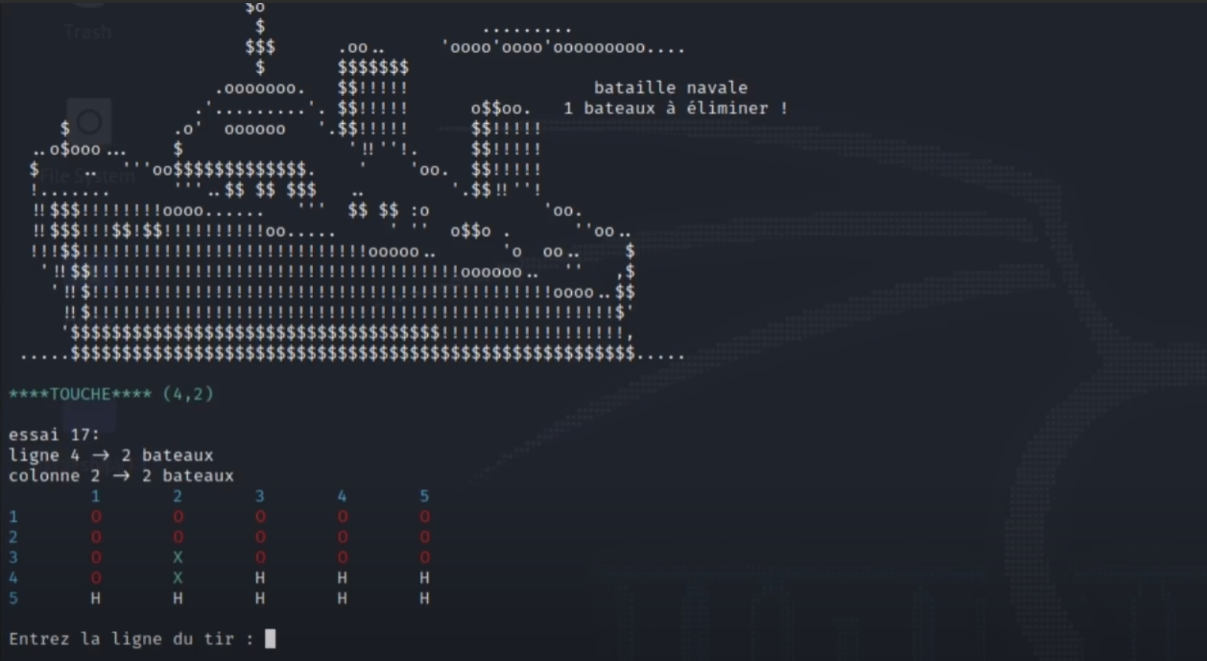SAE 1.05 DATA PROCESSING

During my studies in Networks and Telecommunications, I had the opportunity to engage in the SAE 1.05 Data Processing project. This project was centered around programming in C, where our primary mission was to recreate the classic Battleship game using the C programming language. This endeavor not only allowed me to strengthen my programming skills but also provided valuable insights into software development and problem-solving within a structured project framework.
Project Overview
The SAÉ 1.05 Data Processing project was designed to challenge students to apply their knowledge of the C programming language in a practical and engaging manner. The goal was to develop a fully functional Battleship game, a strategic guessing game where players attempt to sink each other's ships on a grid. This project required a deep understanding of C programming concepts, including data structures, control flow, memory management, and user interaction.
Key Objectives
- Game Development in C: Utilize the C programming language to design and implement the core functionalities of the Battleship game.
- User Interface Design: Create an intuitive and user-friendly interface that allows players to interact with the game seamlessly.
- Algorithm Implementation: Develop efficient algorithms for ship placement, move validation, hit detection, and win condition checks.
- Memory Management: Ensure optimal use of memory by managing dynamic allocations and preventing leaks.
- Debugging and Testing: Rigorously test the game to identify and fix bugs, ensuring a smooth and enjoyable user experience.
Tasks and Responsibilities
1. Planning and Design
The first phase involved planning the game's structure and designing its components. This included outlining the rules of Battleship, defining the game flow, and determining the necessary data structures to represent the game board, ships, and player moves.
2. Coding the Core Mechanics
- Game Board Representation: Implemented a two-dimensional array to represent the game grid, allowing for the placement and tracking of ships and hits.
- Ship Placement: Developed functions to randomly place ships on the grid, ensuring no overlapping and adherence to game rules.
- Move Validation: Created logic to validate player inputs, ensuring moves are within the grid and not repeated.
- Hit Detection: Programmed mechanisms to detect hits and misses, updating the game state accordingly.
- Win Condition: Implemented checks to determine when all ships of a player have been sunk, declaring the winner.
3. User Interface Development
Designed a text-based user interface that displays the game board, prompts players for their moves, and provides feedback on hits, misses, and game status. Emphasized clarity and simplicity to enhance user experience.
4. Memory Management
Managed dynamic memory allocations for components such as ship storage and game history. Ensured proper allocation and deallocation to prevent memory leaks and optimize performance.
5. Debugging and Testing
Conducted thorough testing to identify and resolve bugs. Utilized debugging tools and techniques to streamline the development process, ensuring the game operates smoothly under various scenarios.
Skills Developed
- Proficient C Programming: Enhanced my ability to write efficient and clean C code, leveraging advanced language features to solve complex problems.
- Algorithm Design: Improved my skills in designing and implementing algorithms that are both effective and optimized for performance.
- Problem-Solving: Developed a systematic approach to troubleshooting and resolving issues encountered during the development process.
- Project Management: Gained experience in planning, organizing, and executing a project from inception to completion within set deadlines.
- Attention to Detail: Cultivated a keen eye for detail, ensuring that every aspect of the game operates as intended and provides a seamless user experience.
Conclusion
The SAÉ 1.05 Data Processing project was a significant milestone in my academic journey, allowing me to apply theoretical knowledge in a practical setting. Developing a Battleship game in C not only reinforced my programming skills but also taught me valuable lessons in project management, teamwork, and strategic thinking. This project has equipped me with the confidence and expertise to tackle more complex software development challenges in the future, making it a valuable addition to my professional portfolio.
Engaging in this project underscored the importance of combining technical proficiency with creative problem-solving to deliver functional and enjoyable software solutions. I am proud of the outcome and look forward to leveraging these skills in my future endeavors within the field of cybersecurity and network management.
